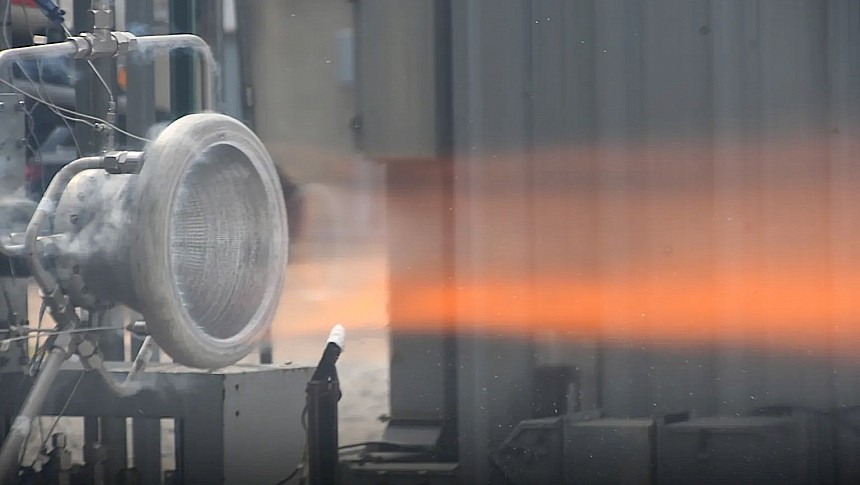Sending rockets to the Moon, Mars, and beyond with humans on board boils down to essentially one thing: being capable of sending with them enough supplies to ensure survival. And that can only be done if we can cut the weight of the rocket itself down as much as possible.
There's a race going on over at NASA at the moment to find lightweight materials that can go into a rocket and make it capable of carrying more. And that race is already bringing the first tangible results.
Enter the Reactive Additive Manufacturing for the Fourth Industrial Revolution program. That's RAMFIRE, for short, and an umbrella name for efforts to advance "lightweight, additively manufactured aluminum rocket nozzles."
The latest development of the project is a 3D-printed rocket nozzle put together by the Marshall Space Flight Center and a company called Elementum 3D. Not only is the nozzle revolutionary in design, but also in terms of the material it's made of.
For the task at hand the two organizations created a new kind of weldable aluminum called A6061-RAM2.
Generally speaking, despite being extremely lightweight and high-strength, aluminum doesn't like being subjected to the extreme heat generated by a rocket engine, and has a tendency to crack during welding. That's why engineers don't really use the stuff to make rocket engine components.
Thanks to the A6061-RAM2 that may change. The material has properties that make it better than conventional aluminum, but was also designed with small internal channels that help the nozzle keep it together and avoid melting during the rocket engine's operation. It's also capable of supporting welding without cracking.
NASA says it has already built and tested two prototype nozzles of this kind earlier this summer at the Marshall East Test Area. Multiple test fires were performed, with several fuels being burned: liquid oxygen, liquid hydrogen, and liquid methane.
During the burns the pressure on the material went past the 825 psi mark, and the nozzles held it together for no less than 22 starts and 579 seconds of burn time.
According to NASA, this proves "the nozzle can survive the thermal, structural, and pressure loads for a lunar lander scale engine."
Not only is the tech operationally sound, but it's a lot easier to make than conventional parts. Whereas regular nozzles need thousands of individually joined parts, the new one is made of a single piece. This makes it both easier and faster to manufacture.
At the time of writing NASA says it's in the process of sharing both the data and the process of making the new aluminum and components based on it with commercial stakeholders and academia.
Other companies, we're told, are in the process of evaluating the A6061-RAM2 for use in satellite making. To date, undisclosed groups were capable of creating a 36-inch diameter aerospike nozzle, but also a vacuum-jacketed tank for cryogenic fluid.
There is no timeline set for something tangible to come out of this, but at the rate things are moving in space exploration we won't be surprised if we see something deployed on real tech soon.
Enter the Reactive Additive Manufacturing for the Fourth Industrial Revolution program. That's RAMFIRE, for short, and an umbrella name for efforts to advance "lightweight, additively manufactured aluminum rocket nozzles."
The latest development of the project is a 3D-printed rocket nozzle put together by the Marshall Space Flight Center and a company called Elementum 3D. Not only is the nozzle revolutionary in design, but also in terms of the material it's made of.
For the task at hand the two organizations created a new kind of weldable aluminum called A6061-RAM2.
Generally speaking, despite being extremely lightweight and high-strength, aluminum doesn't like being subjected to the extreme heat generated by a rocket engine, and has a tendency to crack during welding. That's why engineers don't really use the stuff to make rocket engine components.
Thanks to the A6061-RAM2 that may change. The material has properties that make it better than conventional aluminum, but was also designed with small internal channels that help the nozzle keep it together and avoid melting during the rocket engine's operation. It's also capable of supporting welding without cracking.
NASA says it has already built and tested two prototype nozzles of this kind earlier this summer at the Marshall East Test Area. Multiple test fires were performed, with several fuels being burned: liquid oxygen, liquid hydrogen, and liquid methane.
During the burns the pressure on the material went past the 825 psi mark, and the nozzles held it together for no less than 22 starts and 579 seconds of burn time.
According to NASA, this proves "the nozzle can survive the thermal, structural, and pressure loads for a lunar lander scale engine."
Not only is the tech operationally sound, but it's a lot easier to make than conventional parts. Whereas regular nozzles need thousands of individually joined parts, the new one is made of a single piece. This makes it both easier and faster to manufacture.
At the time of writing NASA says it's in the process of sharing both the data and the process of making the new aluminum and components based on it with commercial stakeholders and academia.
Other companies, we're told, are in the process of evaluating the A6061-RAM2 for use in satellite making. To date, undisclosed groups were capable of creating a 36-inch diameter aerospike nozzle, but also a vacuum-jacketed tank for cryogenic fluid.
There is no timeline set for something tangible to come out of this, but at the rate things are moving in space exploration we won't be surprised if we see something deployed on real tech soon.





